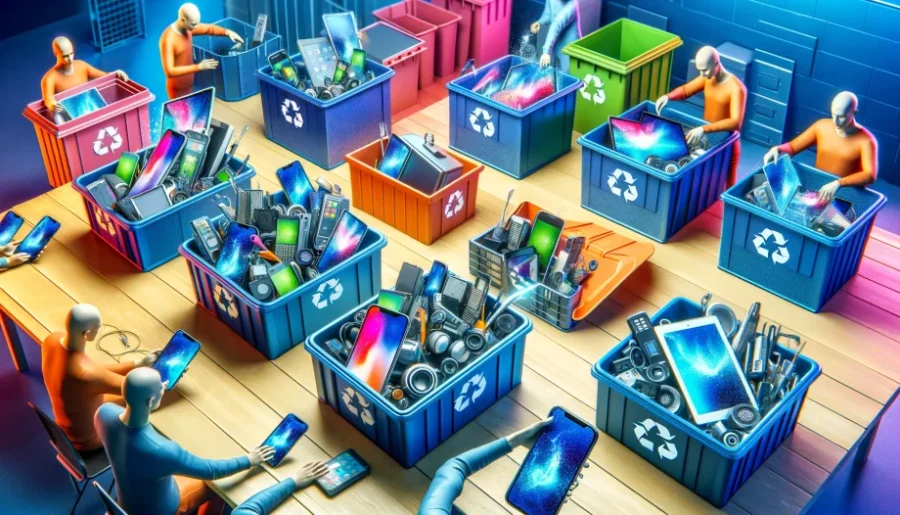
Discover the benefits of recycling electronics responsibly! Learn how to protect the environment and conserve resources with our easy tips and guidelines.
Recycling Electronics Responsibly
Key Takeaways:
Recycling electronics responsibly means properly disposing of electronic devices such as smartphones, laptops, and TVs.
- It involves taking them to certified recycling centers or participating in manufacturer take-back programs.
- This process conserves natural resources, reduces pollution, and protects the environment.
Are you looking for ways to make a positive impact on the environment? Recycling electronics responsibly is a great place to start!
Join us as we explore simple yet effective steps to recycle your old gadgets while conserving precious resources and protecting our planet.
Recycling Electronics Responsibly
The Growing Problem of Electronic Waste (E-Waste)
In today’s fast-paced world, technology is advancing at an unprecedented rate.
With each new innovation, older electronic devices quickly become obsolete, leading to a growing problem known as electronic waste, or e-waste.
E-waste encompasses a wide range of discarded electronic devices, from smartphones and laptops to televisions and refrigerators.
As our reliance on technology continues to increase, so does the volume of e-waste generated each year and the need for responsible recycling of electronics.
The Environmental and Health Risks of E-Waste
The consequences of improperly managed e-waste are far-reaching.
Many electronic devices contain hazardous materials such as lead, mercury, and cadmium, which can leach into the soil and water, posing serious environmental and health risks.
Furthermore, e-waste contributes to the depletion of finite natural resources, as valuable metals like gold, silver, and copper are lost when electronics are not recycled.
The Importance of Recycling Electronics Responsibly
Recognizing the importance of addressing this issue, recycling electronics responsibly has become a crucial endeavor.
Responsible recycling not only prevents harmful substances from polluting the environment but also conserves valuable resources by recovering materials that can be reused in new products.
Additionally, it supports the circular economy, reducing the need for virgin materials and minimizing the carbon footprint associated with manufacturing new electronics.
Making Informed Choices
As consumers and citizens, we play a vital role in mitigating the impact of e-waste.
By making informed choices about how we dispose of our electronic devices, we can contribute to a more sustainable and environmentally friendly future.
In this blog post, we will explore the benefits of electronic waste recycling, the process involved, guidelines for responsible disposal, and what items can be included in electronic recycling.
Together, we can make a difference in the fight against e-waste and pave the way for a greener planet.
Electronic waste recycling, electronics recycling, or e-waste recycling is the disassembly and separation of components and raw materials of waste electronics; when referring to specific types of e-waste, the terms like computer recycling or mobile phone recycling may be used. Like other waste streams, reuse, donation, and repair are common sustainable ways to dispose of IT waste. Wikipedia
Electronic Waste Recycling Benefits
Recycling electronics responsibly offers numerous environmental and economic benefits.
By understanding and embracing these advantages, we can make a positive impact on our planet and its resources.
Conservation of Natural Resources
Electronic devices contain a variety of valuable materials, including metals, plastics, and glass.
Recycling these materials conserves natural resources by reducing the need for new materials to be mined and processed.
For example, recycling one million laptops saves the energy equivalent to the electricity used by more than 3,500 U.S. homes in a year.
Reduction of Pollution and Greenhouse Gas Emissions
Properly recycling electronics helps reduce pollution by preventing hazardous substances from entering the environment.
It also reduces greenhouse gas emissions associated with manufacturing new products.
Recycling metals from e-waste uses a fraction of the energy required to mine and process new metals, leading to significant reductions in carbon emissions.
Energy Savings and Job Creation
Recycling electronics is not only good for the environment but also for the economy.
It requires less energy than producing new products from virgin materials, leading to energy savings.
Additionally, the recycling industry creates jobs in the collection, transportation, and processing of e-waste, contributing to local economies.
Table: Benefits of Recycling Electronics
| Benefit | Description |
|---|---|
| Conservation of Natural Resources | Reduces the need for new materials, conserving finite resources like metals, plastics, and glass. |
| Reduction of Pollution | Prevents hazardous substances from contaminating soil, water, and air. |
| Greenhouse Gas Emission Reduction | Lowers carbon emissions by using less energy compared to manufacturing new products. |
| Energy Savings | Uses less energy than producing new products from virgin materials. |
| Job Creation | Creates employment opportunities in the collection, transportation, and processing of e-waste. |
By highlighting these benefits, we can encourage more people to recycle their electronics responsibly, leading to a healthier planet and a more sustainable future.
Electronics Recycling Process
The process of recycling electronics is a multi-step procedure that ensures the safe and efficient recovery of materials while minimizing environmental impact.
Collection and Transportation of E-Waste
The first step in the electronics recycling process is the collection of discarded electronic devices.
This can be done through various channels, including drop-off centers, take-back programs, and community collection events.
Once collected, the e-waste is transported to recycling facilities for further processing.
Sorting and Dismantling of Electronic Devices
At the recycling facility, electronic devices are sorted based on their type and potential for reuse.
Devices that can be refurbished are separated for repair and resale.
The remaining devices are then dismantled manually or mechanically to separate components and materials.
This step is crucial for effectively recovering valuable materials and ensuring that hazardous substances are handled properly.
Recovery and Recycling of Materials
After dismantling, the separated materials undergo further processing to recover metals, plastics, glass, and other valuable components.
Metals are typically smelted to extract pure materials, while plastics may be shredded and used to manufacture new products.
The recovery process is designed to maximize the amount of reusable materials and minimize waste.
Table: Steps in the Electronics Recycling Process
| Step | Description |
|---|---|
| Collection and Transportation | Gathering e-waste from various sources and transporting it to recycling facilities. |
| Sorting and Dismantling | Separating devices into reusable and recyclable components, and dismantling them accordingly. |
| Recovery and Recycling of Materials | Processing materials to extract valuable components and preparing them for reuse. |
By understanding and following these steps, we can ensure that electronic devices are recycled responsibly, contributing to environmental sustainability and resource conservation.
Electronic Waste Recycling Guidelines
Proper preparation and choosing the right recycling option are crucial for recycling electronics responsibly.
These guidelines ensure that your e-waste is handled safely and effectively.
Preparing Electronics for Recycling
Before recycling your electronic devices, it’s important to prepare them properly to protect your personal information and ensure they are recycled correctly:
- Deleting Personal Information: Wipe all personal data from your devices. This includes performing a factory reset on smartphones, tablets, and computers, and removing any memory cards or SIM cards.
- Removing Batteries: If possible, remove batteries from your devices, as they may need to be recycled separately. Batteries, especially lithium-ion ones, require special handling due to their potential fire hazard.
Finding Certified E-Waste Recycling Centers or Manufacturer Take-Back Programs
Choosing the right recycling option is crucial for ensuring your e-waste is processed responsibly:
- Certified E-Waste Recycling Centers: Look for recycling centers that are certified by programs such as e-Stewards or Responsible Recycling (R2). These certifications ensure that the facility adheres to strict environmental and safety standards.
- Manufacturer Take-Back Programs: Many electronics manufacturers offer take-back programs where you can return your old devices for recycling. These programs often ensure that the e-waste is handled in an environmentally responsible manner.
Table: Guidelines for Recycling Electronics Responsibly
| Guideline | Description |
|---|---|
| Deleting Personal Information | Wipe all personal data from devices to protect your privacy. |
| Removing Batteries | Remove batteries for separate recycling, especially if they are lithium-ion. |
| Certified E-Waste Recycling Centers | Choose centers certified by e-Stewards or R2 to ensure responsible recycling practices. |
| Manufacturer Take-Back Programs | Utilize take-back programs offered by manufacturers for a convenient and responsible recycling option. |
By following these guidelines, you can contribute to the responsible recycling of electronics, helping to protect the environment and conserve valuable resources.
What is Included in Electronic Recycling?
Electronic recycling encompasses a wide range of devices and materials, ensuring that valuable resources are recovered and hazardous substances are properly managed.
Types of Electronic Devices That Can Be Recycled
- Computers: This includes desktops, laptops, servers, and their components like hard drives, RAM, and motherboards.
- Smartphones and Tablets: Mobile devices are rich in valuable materials and can often be refurbished or recycled.
- Televisions and Monitors: Both CRT and flat-screen TVs and monitors can be recycled for their glass and metal content.
- Printers, Scanners, and Copiers: Office equipment contains plastics, metals, and electronic components that can be recycled.
- Audio and Video Equipment: Stereos, DVD players, game consoles, and speakers are examples of entertainment electronics that can be recycled.
- Small Appliances: Microwaves, toasters, and coffee makers, among others, can be recycled for their metal and plastic components.
Materials Recovered from Electronic Recycling
- Metals: Copper, aluminum, gold, silver, and palladium are commonly recovered from electronic devices and used in new products.
- Plastics: Plastics from casings and components can be recycled into new products or used as fuel in energy recovery processes.
- Glass: Glass from screens and monitors can be recycled into new glass products or used in construction materials.
- Rare Earth Elements: These are used in small quantities in electronics but are critical for their functionality and can be recovered during recycling.
Table: Commonly Recycled Electronics and Their Components
| Electronic Device | Components/Materials Recovered |
|---|---|
| Computers | Metals, plastics, glass, rare earth elements |
| Smartphones and Tablets | Metals, plastics, rare earth elements |
| Televisions and Monitors | Glass, metals, plastics |
| Printers, Scanners, Copiers | Metals, plastics, electronic components |
| Audio and Video Equipment | Metals, plastics, electronic components |
| Small Appliances | Metals, plastics |
By recycling these devices and materials, we can reduce the environmental impact of electronic waste, conserve natural resources, and reduce the demand for new materials.
Recycling Electronics Responsibly FAQs
Recycling electronics is a topic that often raises questions about its effectiveness and impact.
Here are some frequently asked questions to help clarify the importance and benefits of recycling electronics responsibly.
Q: Are electronics actually recycled?
A: Yes, electronics can be recycled to recover valuable materials such as metals, plastics, and glass.
These materials can then be used to manufacture new products, reducing the need for virgin resources and preventing environmental pollution.
Q: Why is recycling electronics good for the environment?
A: Recycling electronics conserves natural resources, reduces pollution, and saves energy.
It prevents hazardous substances from contaminating soil and water and reduces greenhouse gas emissions associated with manufacturing new products.
Q: How can I ensure my personal data is safe when recycling electronics?
A: Before recycling your electronics, make sure to back up any important data and then perform a factory reset or use data-wiping software to erase all personal information.
This will protect your privacy and prevent any potential data breaches.
Q: Can all electronic devices be recycled?
A: Most electronic devices can be recycled, including computers, smartphones, televisions, and small appliances.
However, it’s important to check with your local recycling center or take-back program to see what types of electronics they accept and any specific preparation required.
Q: Where can I recycle my old electronics?
A: You can recycle your old electronics at certified e-waste recycling centers, through manufacturer take-back programs, or at community recycling events.
Check with your local waste management authority or search online for nearby recycling options.
By addressing these FAQs, we aim to promote a better understanding of the importance of recycling electronics responsibly and encourage more people to participate in this crucial environmental effort.
Recycling Electronic Waste Conclusion
Recycling electronics responsibly is essential for our environment and future generations.
It conserves resources, reduces pollution, and supports a sustainable economy.
By taking action to properly dispose of electronic waste, we contribute to a cleaner, healthier planet. Let’s embrace this responsibility and make a positive impact together.
The Importance of Responsible Recycling
Recycling electronics is not just about getting rid of old devices; it’s about making a conscious effort to protect our environment and conserve resources.
By recycling, we ensure that valuable materials are recovered and reused, reducing the need for new resources and minimizing the environmental impact of electronic waste.
Taking Action
The responsibility of recycling electronics lies with each of us. It’s up to us to make informed decisions about how we dispose of our electronic devices.
Whether it’s taking your old smartphone to a certified recycling center or participating in a manufacturer’s take-back program, every small action contributes to a larger positive outcome.
A Call to Action
As consumers, we have the power to drive change.
By choosing to recycle our electronics responsibly, we send a message to manufacturers and policymakers about the importance of sustainability.
Let’s lead by example and encourage others to join us in this crucial endeavor.
Read more: Mastering Zero-Waste Living: 7 Easy Tips and Tricks
Resources
To help you recycle your electronics responsibly, here are some valuable resources:
List of Certified E-Waste Recycling Centers
- e-Stewards: Find a certified e-Stewards recycler near you by visiting the e-Stewards’ website.
- Responsible Recycling (R2): Locate R2-certified recyclers by checking the Sustainable Electronics Recycling International (SERI) directory.
Manufacturer Take-Back Programs
- Apple Recycling Program: Apple’s recycling program allows you to trade in eligible devices for credit or recycle them for free.
- Dell Recycling Program: Dell offers various recycling options for consumers and businesses.
- Samsung Take-Back Program: Samsung’s program provides options for recycling their products.
Online Resources for More Information on Electronic Recycling
- U.S. Environmental Protection Agency (EPA): The EPA offers guidelines and information on electronics donation and recycling.
-
International E-Waste Management Network (IEMN) EPA
- Earth911: Use Earth911’s Recycling Search to find recycling centers for various types of electronics.
- RecycleNation: RecycleNation’s website provides a searchable database of recycling locations and information on recycling different materials.
By utilizing these resources, you can ensure that your electronic devices are recycled in an environmentally responsible manner.






